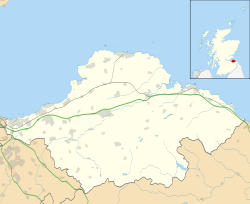Earls of Haddington
In 1628 when Thomas Hamilton, 1st Earl of Haddington received that title in exchange for that of Earl of Melrose he acquired Tyninghame by purchase. [3] He gave the house and furnishings to his son in 1635, and an inventory was made of the contents. The building then comprised an old tower with newer wings or "jambs" over vaulted cellars. [6] Thomas Hamilton, 2nd Earl of Haddington was killed in an explosion at Dunglass Castle in 1640, and by 1669 the 5th Earl had inherited the property. He married Margaret Leslie, 8th Countess of Rothes, daughter of the Duke of Rothes, and lived mainly on his wife's estate. [2] His son, the 6th Earl, took up residence at Tyninghame following his marriage to Helen Hope around 1700. The couple found the estate in poor condition and set about renovating and replanting. His wife is largely responsible for the layout of the parks which survives today, including avenues, plantations, and the 400 acres (160 ha) Binning Wood. She named the wood after their son. [7] Inspired by his wife to become a noted agricultural improver, the Earl wrote a book, A Treatise on the Manner of Raising Forest Trees, published in 1761. [2] [7]
In 1791 Charles, the 8th Earl, renovated the house, [4] but these were superseded by the works carried out by the 9th Earl. In 1828 he commissioned William Burn to redesign the house in the Scots Baronial style. Burn made only limited alterations to the plan of the house but totally altered the elevations, refacing most of the building in red sandstone, and adding turrets and other details. [3] The original 17th-century masonry can be seen on the south facade. [1] The 9th Earl also carried out further plantings in the parks and erected an obelisk in 1856 to commemorate the work of the 5th Earl. [2]
On the death of the 9th Earl in 1858, the estate was inherited by a cousin, George Baillie of Mellerstain. His son, the 11th Earl, carried out further plantings in the 1880s, including the Walled Gardens. Formal gardens, including Lady Haddington's Secret Garden, were established by the 12th Earl and his wife in the 20th century. [2] The house was featured in Country Life on 7 August 1975, and in Scottish Field in August 1953. After the 12th Earl died in 1986, the 13th Earl chose to retain Mellerstain House near Duns, Berwickshire as his main residence, and Tyninghame was sold the following year. The bulk of the contents were auctioned by Sotheby's in a two-day sale at the house, on 28–29 September 1987. [8] The house was then divided into apartments by country house developer Kit Martin.

